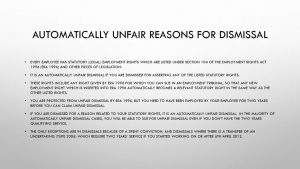Wrongful Dismissal VS Wrongful Discharge – What’s the Difference?
Wrongful Dismissal VS Wrongful Discharge
Wrongful dismissal is a very common and complicated area of the law. Essentially, it states that if there has been a contract or employment relationship between an employer and an employee, and that contract has been terminated, then the employee can sue the employer for breach of contract and wrongful dismissal. However, with wrongful dismissal law, there are two distinct arguments that can be brought forward: actual and constructive. If you have been involved in a case of wrongful dismissal, you should consult a solicitor as soon as possible to discuss your case.
With a constructive dismissal claim, an employee must show that there was an actual termination. This action must be proved by either company records that prove the date of termination, or by clear and convincing evidence that the employee was told, authorised or requested that a notice of termination is given. In the UK, there is a British Law minimum requirement that a notice of termination must state clearly that the employee will lose their right to continue working. Constructive dismissal claims are also quite difficult to prove because unless there is direct and incontrovertible proof that an employee was made aware of their rights to a notice of termination, there is no basis for a successful claim. For this reason, many employers will try and avoid the expense and risk of such a complex and potentially costly action.

On the other hand, when dealing with wrongful dismissal, there is not a clear cut case that can be proven by either company or employee. There are two things to consider: negligence and intention. Negligence refers to actions or omissions by an employer that led to the wrongful dismissal, such as breaking employment terms or harassment; while intent refers to such activities as trying to quell disputes or quell the effect of negative criticism.
Wrongful Dismissal VS Wrongful Discharge – What’s the Difference?
In the majority of cases where a worker is wrongfully dismissed, the employer has been acting in bad faith. In these circumstances, the employer would normally be liable to pay compensation. In contrast, intent is not a defence, so the employer cannot simply say “but we didn’t do it!” The only way to prove intent is through actions taken. For example, if you were making repairs at your workplace and one of your co-workers complained about it, you could argue that you had in fact done the work and your co-worker’s complaint was unjustified.
Another thing to consider is jurisdiction. If the incident happened in a state other than your country, the UK courts will have more jurisdiction over the case. You should check the county court website to find a local court where the event occurred. It is unlikely that the Employment Tribunal would have jurisdiction over the case as it is an international case. Even if it did hear it, the ruling may be against you because of lack of expertise on your side in the UK.
Wrongful dismissal claims are usually very hard to prove as most cases result in a claim being thrown out. The exception to this is where the employer has acted deliberately and behaved in a manner that shows they knew their actions would result in a dismissal. These types of cases are very difficult to win as the employer usually has proof of intent and incontrovertible proof of continuing behavior. It can be hard for an employee to recover money unless they can prove their case beyond doubt. Even then, most cases end in the employer paying out as the courts often prefer to take the employer’s money rather than an employee who is genuinely distressed.